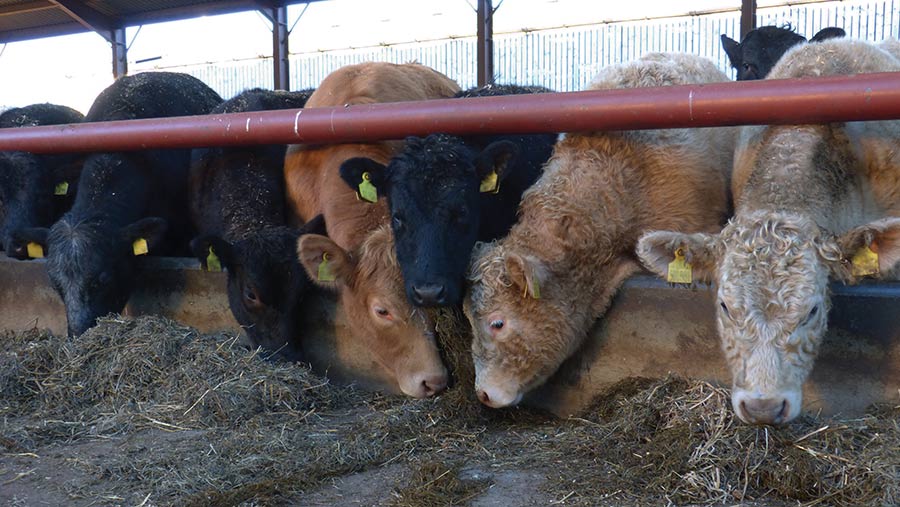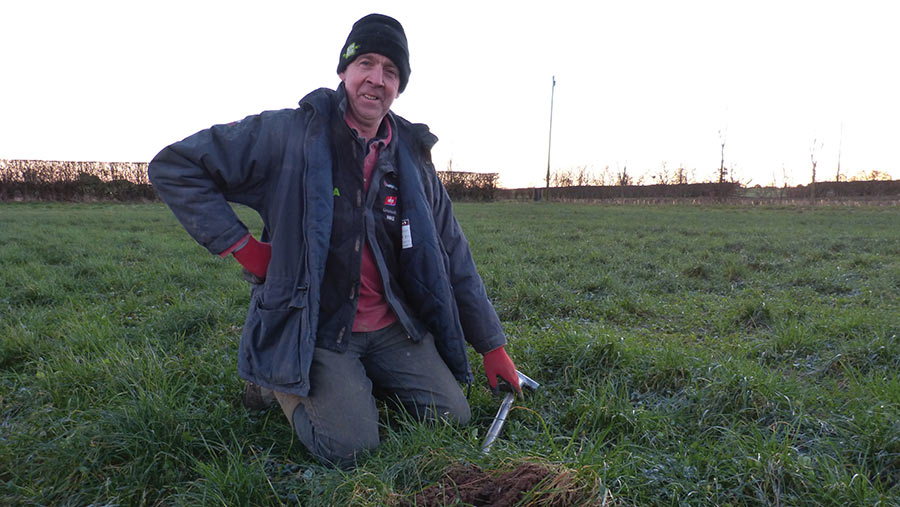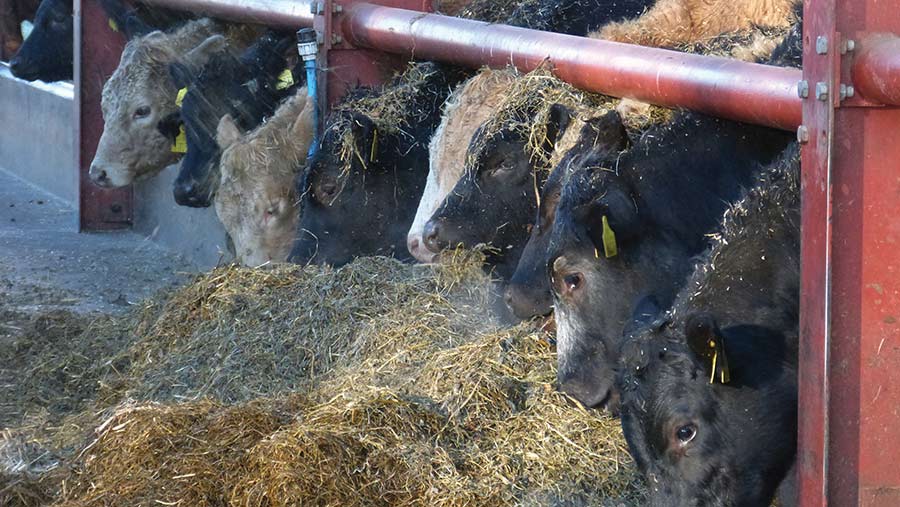How red clover and ryegrass save £1 a day on bull diet
 © MAG/Michael Priestley
© MAG/Michael Priestley A Vale of York suckler/finisher unit has harnessed the power of home-grown clover and ryegrass to save more than £1 a head a day in the finishing shed.
Mike Powley says growing a 50-50 mix of red clover and Italian ryegrass is a “win-win-win-win” for beef margins, soil health, arable inputs and biodiversity at Oak House Farm, Green Hammerton.
Over the past 10 years, he has integrated regenerative soil health principles into his farm to benefit both arable and beef costs for his spring-calving South Devon-cross herd.
Mike has saved at least 8kg a head a day in the bull system by feeding clover-ryegrass silage. He has also cut nitrogen use by 40% and eradicated all pesticides, as well as potassium and phosphate buying on the arable unit.
Farm facts: Oak House Farm
- Greenfield site developed from 2017-19 after selling the old farm in the village
- 145ha, of which half is arable and half grassland
- 48ha owned, the rest rented from six landlords
- 24ha of reseeded grass, 24ha parkland in Higher Level Stewardship, and 24ha of permanent pasture
- 117 suckler cows to calve this year
- Supplies ABP deadweight
- Clay loam over clay and a lighter ridge to the west of the farm

Mike Powley © MAG/Michael Priestley
System switch
Previously, the farm was on a ration of ad-lib barley, protein balancer, molasses and straw, with bulls eating 10-12kg/day of barley on average.
Using rough costings based on soya at £440/t, barley and beans (replacing the costly protein balancer) at £170/t (to cover milling cost on farm) and molasses at £270/t, it cost £2.59 to feed 12kg/day dry matter (DM).
This left a margin over feed of £2.41 when set against 1kg/day of carcass gain (carcass valued at £5/kg). Now, using a 250kg DM silage bale valued at £20 (8p/kg DM) allows Mike to replace 8kg of barley, costing 19.5p/kg DM.
With molasses, straw and a 7% inclusion of home-grown beans (milled at a neighbour’s farm), total cost is £1.55 a head a day, giving a margin over feed of £3.45.
Mike says: “The clear benefit to the cattle enterprise is the cost saving, but the cattle are happier for it too, as there’s no sub-acute ruminal acidosis.
Bulls lie down and cud, and still get to 400kg carcass weights averaging 1.5kg/day of liveweight gain across their lives, and the top 20% are doing 1kg/day of carcass gain.”
Cross-breeding
Having an easy-fleshing South Devon genetic base helps with forage utilisation, explains Mike, who has previously crossed with Limousin (for carcass) and Norwegian Red (for milk, foot and udder structure, and fertility) and is now criss-crossing with Angus straws and South Devon stock bulls.
“We are less bothered about carcass than we were when the beef price was £2.50/kg and E grades brought a 22p/kg bonus and 10% of our income,” he says. “The bonus has not increased, and the beef price is £5/kg now.”

© MAG/Michael Priestley
Future
Mike will look to add more species to the clover silage mix (see “How the system works”), allowing him to pick up the GS4 payment (£382/ha).
Increasing and maintaining species diversity will be a new challenge, but it should improve insect habitat and bring greater variety of root depths and structures to aggregate the soil.
How the system works
- Growing A seed rate of 15kg/ha is direct-drilled. The mix (from Hurrells Seeds) is designed to last three years and consists of two red clovers (1.75kg of Atlantis and 1.75kg of Harmionie), two late diploid perennial ryegrass (PRG) varieties (2.55kg Aston King and 3.01kg Toddington) and two late tetraploid PRGs (3.3kg Nashota and 2.6kg Montova).
- Rotating This clover mix is grown for the first three years of an eight-year rotation on the arable land. It is followed by winter wheat, winter barley, spring beans after a cover crop, winter wheat, and winter barley.
- Harvesting The first of four silage cuts is in May, using a cutter, a hay bob and a “wuffler” that gently flips over the swath to aid drying. A tedder is used early on a dewy morning to prevent leaf shatter and protein loss. Local contractor WT Webster & Sons bales and wraps the crop at opportune moments.
- Analysing In damp conditions, a 48-hour wilt may be required to make a 35-50% dry matter (DM) silage. The aim is 18% crude protein and 10.5-11.5MJ/kg metabolisable energy (ME), with digestibility (D) values of 72-75% and high intake potential, based on Trouw Nutrition’s analysis. Last year’s silage was 52.1% DM, 17.2% protein, 74.1% D-value and 11.9MJ/kg ME.
- Feeding Cattle are fed morning and evening on a raised 1.52m-wide concrete feed passage. This is covered by a 1.62m roof overhang, which helps keep feed dry and DM intakes up. Bales are shredded onto the feed face using a straw chopper, and the cereal is top-dressed from a barrow.
- Housing Bulls are kept in one large group of 50 or so. Feed space runs along the inside of the 45×13.7m shed, giving close to 1m of feed space a head.
- Carcass recording Cattle reach 400kg carcasses in their 13th month on the clover-grass silage ration. Most cattle are U-grades. Continental-crosses kill out at 62-63%, while the Norwegian Red-bred cattle kill out at about 57%.
Mike Powley’s tips for using clover silage
- To replace significant amounts of barley, you must cut before heading dates and have a silage with 72% digestibility value or more
- Experiment with high residuals after the cutter for regrowth
- Varieties of clover and grass must be selected carefully so they do not crowd each other out
- Avoid cutting corners when ensiling. Use an additive suitable for clover, such as a Lactobacillus plantarum product
- Wrap the silage six times to avoid spoilage – a bale of good-quality silage was worth £112 in 2023 (compared with finishing cake at £360/t), so an extra 80p/bale on wrap is a worthwhile investment
- Know where each cut of silage is in the yard. Target the best silage at youngstock and lower-quality silage, made during catchy periods, at cows
